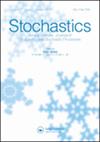Worst-case portfolio optimization with proportional transaction costs
IF 0.8
4区 数学
Q3 MATHEMATICS, APPLIED
Stochastics-An International Journal of Probability and Stochastic Processes
Pub Date : 2015-02-20
DOI:10.1080/17442508.2014.991325
引用次数: 13
Abstract
We study optimal asset allocation in a crash-threatened financial market with proportional transaction costs. The market is assumed to be either in a normal state, in which the risky asset follows a geometric Brownian motion, or in a crash state, in which the price of the risky asset can suddenly drop by a certain relative amount. We only assume the maximum number and the maximum relative size of the crashes to be given and do not make any assumptions about their distributions. For every investment strategy, we identify the worst-case scenario in the sense that the expected utility of terminal wealth is minimized. The objective is then to determine the investment strategy which yields the highest expected utility in its worst-case scenario. We solve the problem for utility functions with constant relative risk aversion using a stochastic control approach. We characterize the value function as the unique viscosity solution of a second-order nonlinear partial differential equation. The optimal strategies are characterized by time-dependent free boundaries which we compute numerically. The numerical examples suggest that it is not optimal to invest any wealth in the risky asset close to the investment horizon, while a long position in the risky asset is optimal if the remaining investment period is sufficiently large.交易成本成比例的最坏情况投资组合优化
研究了具有交易成本成比例的金融市场崩溃威胁下的最优资产配置问题。假设市场要么处于正常状态,即风险资产遵循几何布朗运动,要么处于崩溃状态,即风险资产的价格可能突然相对下降一定数量。我们只假设崩溃的最大数量和最大相对大小,而不对其分布做出任何假设。对于每一种投资策略,我们在终端财富的预期效用最小化的意义上确定了最坏的情况。然后,目标是确定在最坏情况下产生最高预期效用的投资策略。我们使用随机控制方法来解决具有恒定相对风险厌恶的效用函数问题。我们将值函数描述为二阶非线性偏微分方程的唯一粘度解。最优策略具有随时间变化的自由边界,并对其进行了数值计算。数值示例表明,将任何财富投资于接近投资期限的风险资产并不是最优的,而在剩余投资期限足够大的情况下,持有风险资产的多头头寸是最优的。
本文章由计算机程序翻译,如有差异,请以英文原文为准。
求助全文
约1分钟内获得全文
求助全文
来源期刊

Stochastics-An International Journal of Probability and Stochastic Processes
MATHEMATICS, APPLIED-STATISTICS & PROBABILITY
CiteScore
1.90
自引率
0.00%
发文量
42
审稿时长
>12 weeks
期刊介绍:
Stochastics: An International Journal of Probability and Stochastic Processes is a world-leading journal publishing research concerned with stochastic processes and their applications in the modelling, analysis and optimization of stochastic systems, i.e. processes characterized both by temporal or spatial evolution and by the presence of random effects.
Articles are published dealing with all aspects of stochastic systems analysis, characterization problems, stochastic modelling and identification, optimization, filtering and control and with related questions in the theory of stochastic processes. The journal also solicits papers dealing with significant applications of stochastic process theory to problems in engineering systems, the physical and life sciences, economics and other areas. Proposals for special issues in cutting-edge areas are welcome and should be directed to the Editor-in-Chief who will review accordingly.
In recent years there has been a growing interaction between current research in probability theory and problems in stochastic systems. The objective of Stochastics is to encourage this trend, promoting an awareness of the latest theoretical developments on the one hand and of mathematical problems arising in applications on the other.
 求助内容:
求助内容: 应助结果提醒方式:
应助结果提醒方式:


